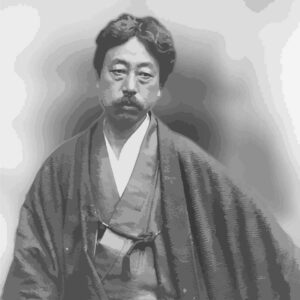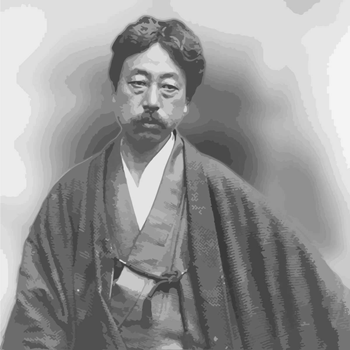
Leader of the Meiji art world. Born in 1862, he was the second son of Kan’emon Okakura, a Yokohama trader and former samurai of the Fukui domain. He graduated from the University of Tokyo in 1880 and joined the Ministry of Education, Culture, Sports, Science and Technology, where he engaged in research on Japanese art in cooperation with Fenollosa, an American teacher at the University of Tokyo. In 1898 (31st year of the same year), he went into retirement and founded the Japan Art Institute with Hashimoto Masakuni, Shimomura Kanzan, Yokoyama Taikan, Hishida Shunso, and others, and devoted himself to the reform of the art world.
In 1901 (34) he traveled around India, and from 1904 (37) he served as Director of the Oriental Department of the Museum of Fine Arts in Boston, U.S.A. During this time, he traveled back and forth to other countries and taught Oriental art history at the University of Tokyo. He died on September 2, 1913 at Akakura Villa in Niigata Prefecture at the age of 51. Tenshin led the Japanese art world with his high-minded and outstanding insight, and wrote a trilogy in English, “Oriental Ideals,” “Awakening Japan,” and “The Book of Tea,” which clearly defined the ideals of the Japanese and Oriental spirit. The original name of “The Book of Tea” was “The Book of Tea.
The book was published by Fox Duffield in New York in 1906, and a translation by Hiroshi Muraoka was published in 1929 as the Iwanami Bunko (Iwanami Library). The contents are divided into the following chapters: Chapter 1, The Bowl of Humanity; Chapter 2, The Styles of Tea; Chapter 3, Taoism and Zen Buddhism; Chapter 4, The Tea House; Chapter 5, Art Appreciation; Chapter 6, Flowers; and Chapter 7, Tea Mastery. This book is not only a must-read for Japanese people, but has also been translated into German and French, and is a book of achievement in spreading the Way of the Tea Ceremony throughout the world. Tenshin learned the actual tea ceremony from Shoami and others early on, and was widely familiar with the “Tea Sutra” and other Chinese and Japanese tea books.



